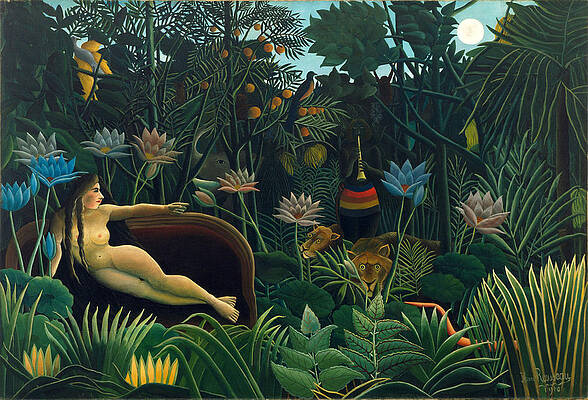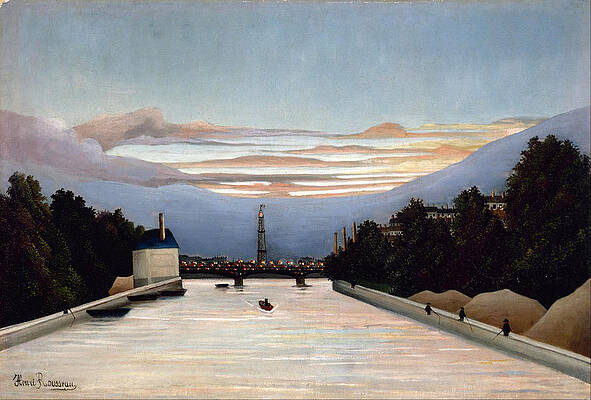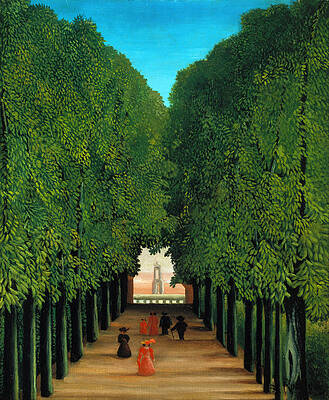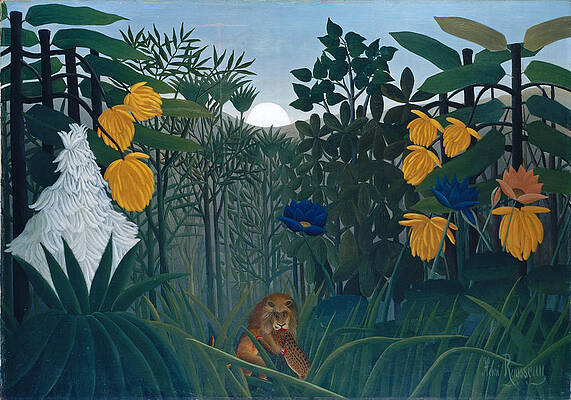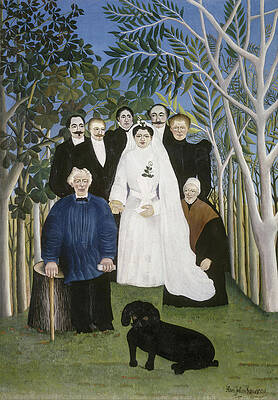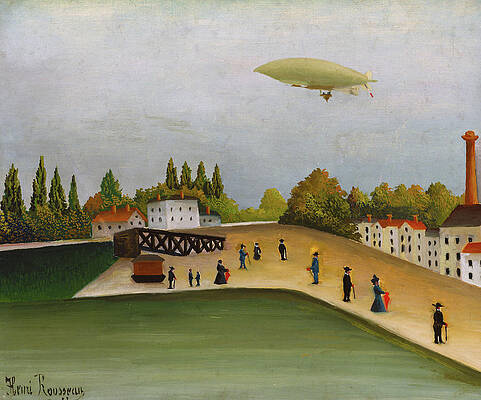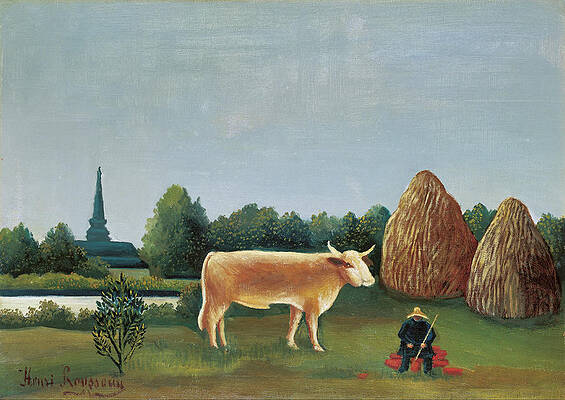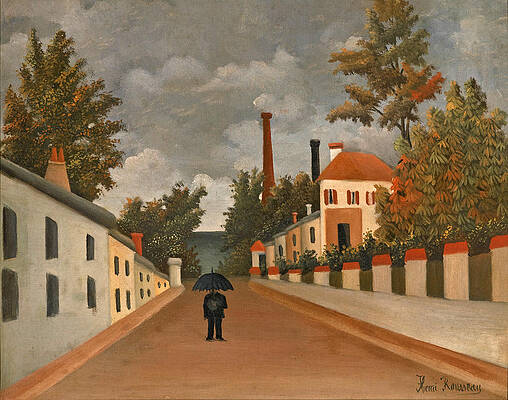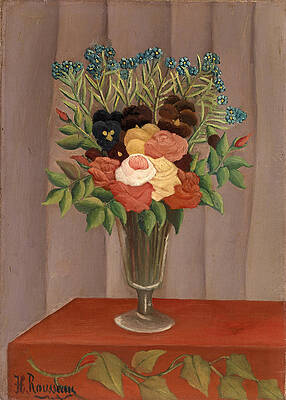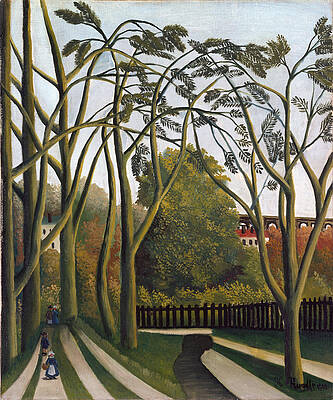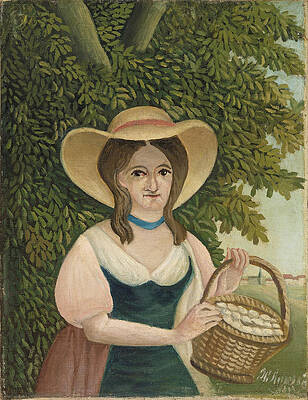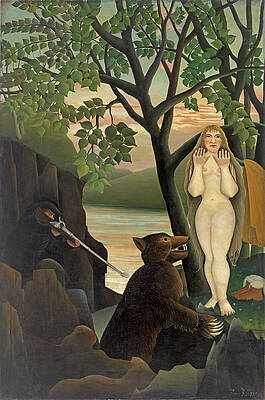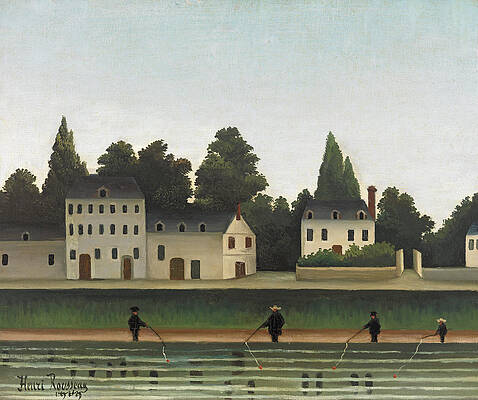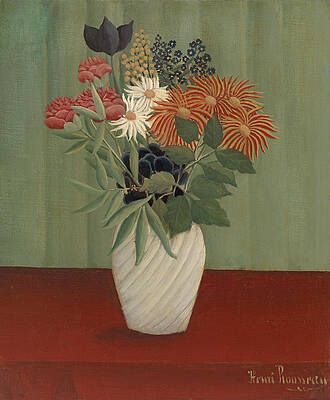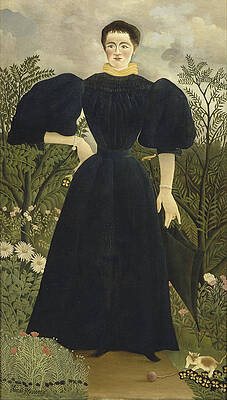Henri Rousseau
Paintings
The Dream
The Sleeping Gypsy
Monkeys and Parrot in the Virgin Forest
The Snake Charmer
Struggle between Tiger and Bull
The Football Players
Surprised
La Carriole du pere Junier
The Pink Candle
Tropical Forest with Monkeys
The Eiffel Tower
Meadowland. The Pasture
The Avenue in the Park at Saint Cloud
A Centennial of Independence
War
Eve
The Tabby
The Repast of the Lion
The Wedding Party
Quai d'Ivry
Scene in Bagneux on the Outskirts of Paris
Vue des environs de Paris
Bouquet of Flowers
The Banks of the Bievre near Bicetre
The Rabbit's Meal
Scouts Attacked by a Tiger
Woman with Basket of Eggs
Unpleasant Surprise
The Past and the Present, or Philosophical Thought
The Family
Portrait of a Woman in a Landscape
The Laundry Boat of Pont de Charenton
A Rainy Morning
Rendezvous in the Forest
Landscape and Four Young Girls
Landscape and Four Fisherman
Bouquet of Flowers with China Asters and Tokyos
The Representatives of Foreign Powers Coming to Greet the Republic as a Sign of Peace
Portrait of Madame M
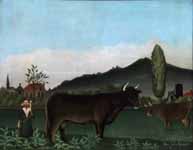
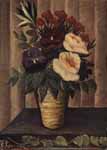
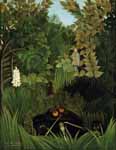
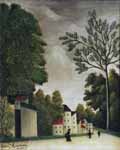
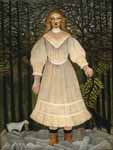
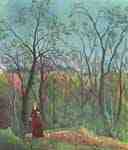
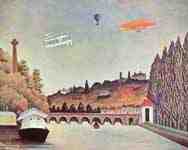
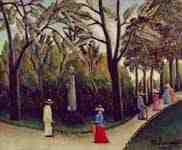
The Chopin monument in the Jardin du Luxembourg

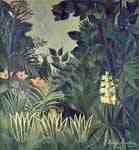

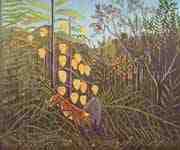
Struggle between Tiger and Buffalo
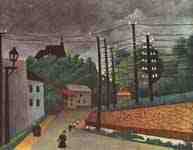

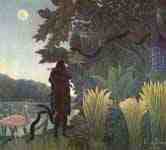
Fine Art Prints | Greeting Cards | Phone Cases | Lifestyle | Face Masks | Men's , Women' Apparel | Home Decor | jigsaw puzzles | Notebooks | Tapestries | ...
Henri Julien Félix Rousseau (French: [ɑ̃ʁi ʒyljɛ̃ feliks ʁuso]; May 21, 1844 – September 2, 1910)[1] was a French Post-Impressionist painter in the Naïve or Primitive manner.[2][3] He was also known as Le Douanier (the customs officer), a humorous description of his occupation as a toll collector.[1] Ridiculed during his lifetime by critics, he came to be recognized as a self-taught genius whose works are of high artistic quality.[4][5] Rousseau's work exerted an extensive influence on several generations of avant-garde artists.[6]
Background
Henri Rousseau was born in Laval, France, in 1844 into the family of a plumber; he was forced to work there as a small boy.[7] He attended Laval High School as a day student and then as a boarder, after his father became a debtor and his parents had to leave the town upon the seizure of their house. Though mediocre in some of his high school subjects, Rousseau won prizes for drawing and music.[8] After high school, he worked for a lawyer and studied law, but "attempted a small perjury and sought refuge in the army."[9] He served four years, starting in 1863. With his father's death, Rousseau moved to Paris in 1868 to support his widowed mother as a government employee. In 1868, he married Clémence Boitard, his landlord's 15-year-old daughter, with whom he had six children (only one survived). In 1871, he was appointed as a collector of the octroi of Paris, collecting taxes on goods entering Paris. His wife died in 1888 and he married Josephine Noury in 1898. He started painting seriously in his early forties; by age 49, he retired from his job to work on his art full-time.[6]
Rousseau claimed he had "no teacher other than nature",[3] although he admitted he had received "some advice" from two established Academic painters, Félix Auguste Clément and Jean-Léon Gérôme.[10] Essentially, he was self-taught and is considered to be a naïve or primitive painter.
Paintings
Self-portrait of the Artist with a Lamp
His best-known paintings depict jungle scenes, even though he never left France or saw a jungle. Stories spread by admirers that his army service included the French expeditionary force to Mexico are unfounded. His inspiration came from illustrated books and the botanical gardens in Paris, as well as tableaux of taxidermy wild animals. He had also met soldiers during his term of service who had survived the French expedition to Mexico, and he listened to their stories of the subtropical country they had encountered. To the critic Arsène Alexandre, he described his frequent visits to the Jardin des Plantes: "When I go into the glass houses and I see the strange plants of exotic lands, it seems to me that I enter into a dream."
Along with his exotic scenes there was a concurrent output of smaller topographical images of the city and its suburbs.
He claimed to have invented a new genre of portrait landscape, which he achieved by starting a painting with a specific view, such as a favourite part of the city, and then depicting a person in the foreground.
Criticism and recognition
Tiger in a Tropical Storm (Surprised!) (1891) was the first of many jungle scenes for which Rousseau is best known.
Rousseau's flat, seemingly childish style was disparaged by many critics; people often were shocked by his work or ridiculed it.[5][11] His ingenuousness was extreme, and he always aspired, in vain, to conventional acceptance. Many observers commented that he painted like a child, but the work shows sophistication with his particular technique.[3][5]
From 1886, he exhibited regularly in the Salon des Indépendants, and, although his work was not placed prominently, it drew an increasing following over the years. Tiger in a Tropical Storm (Surprised!) was exhibited in 1891, and Rousseau received his first serious review, when the young artist Félix Vallotton wrote: "His tiger surprising its prey ought not to be missed; it's the alpha and omega of painting." Yet it was more than a decade before Rousseau returned to depicting his vision of jungles.[6]
In 1893, Rousseau moved to a studio in Montparnasse where he lived and worked until his death in 1910.[12] In 1897, he produced one of his most famous paintings, La Bohémienne endormie (The Sleeping Gypsy).
The Hungry Lion Throws Itself on the Antelope, 1905
In 1905, Rousseau's large jungle scene The Hungry Lion Throws Itself on the Antelope was exhibited at the Salon des Indépendants near works by younger leading avant-garde artists such as Henri Matisse, in what is now seen as the first showing of The Fauves. Rousseau's painting may even have influenced the naming of the Fauves.[6]
In 1907, he was commissioned by artist Robert Delaunay's mother, Berthe, Comtesse de Delaunay, to paint The Snake Charmer.
Le Banquet Rousseau
When Pablo Picasso happened upon a painting by Rousseau being sold on the street as a canvas to be painted over, the younger artist instantly recognised Rousseau's genius and went to meet him. In 1908, Picasso held a half serious, half burlesque banquet in his studio at Le Bateau-Lavoir in Rousseau's honour.[1] Le Banquet Rousseau, "one of the most notable social events of the twentieth century," wrote American poet and literary critic John Malcolm Brinnin, "was neither an orgiastic occasion nor even an opulent one. Its subsequent fame grew from the fact that it was a colorful happening within a revolutionary art movement at a point of that movement's earliest success, and from the fact that it was attended by individuals whose separate influences radiated like spokes of creative light across the art world for generations."[13]
Guests at the banquet Rousseau included: Guillaume Apollinaire, Jean Metzinger, Juan Gris, Max Jacob, Marie Laurencin, André Salmon, Maurice Raynal, Daniel-Henri Kahnweiler, Leo Stein, and Gertrude Stein.[14]
Maurice Raynal, in Les Soires de Paris, 15 January 1914, p. 69, wrote about "Le Banquet Rousseau".[15] Years later the French writer André Salmon recalled the setting of the illustrious banquet:
"Here the nights of the Blue Period passed... here the days of the Rose Period flowered... here the Demoiselles d'Avignon halted in their dance to re-group themselves in accordance with the golden number and the secret of the fourth dimension... here fraternized the poets elevated by serious criticism into the School of the Rue Ravignan... here in these shadowy corridors lived the true worshippers of fire ... here one evening in the year 1908 unrolled the pageantry of the first and last banquet offered by his admirers to the painter Henri Rousseau called the Douanier."[13][14][16]
Retirement
After Rousseau's retirement in 1893, he supplemented his small pension with part-time jobs and work such as playing a violin in the streets. He also worked briefly at Le petit journal, where he produced a number of its covers.[6]
The Dream (1910), MoMA
Rousseau exhibited his final painting, The Dream, in March 1910, at the Salon des Independants and in the same month suffered a phlegmon in his leg which he ignored.[17] In August he was admitted to the Necker Hospital[18] in Paris where his son had died and was found to have gangrene in his leg. On 2 September 1910 after an operation he died from a blood clot. At his funeral, seven friends stood at his grave: the painters Paul Signac and Manuel Ortiz de Zárate, the artist couple Robert Delaunay and Sonia Terk, the sculptor Brâncuși, Rousseau's landlord Armand Queval and Guillaume Apollinaire who wrote the epitaph Brâncuși put on the tombstone:
We salute you Gentle Rousseau you can hear us.
Delaunay, his wife, Monsieur Queval and myself.
Let our luggage pass duty free through the gates of heaven.
We will bring you brushes paints and canvas.
That you may spend your sacred leisure in the
light and Truth of Painting.
As you once did my portrait facing the stars, lion and the gypsy.
Legacy
Rousseau in 1902
Rousseau's work exerted an extensive influence on several generations of avant-garde artists, including Pablo Picasso, Jean Hugo, Fernand Léger Jean Metzinger, Max Beckmann, and the Surrealists. According to Roberta Smith, an art critic writing in The New York Times: "Beckmann’s amazing self-portraits, for example, descend from the brusque, concentrated forms of Rousseau’s portrait of the writer Pierre Loti."[6][19]
In 1911, a retrospective exhibition of Rousseau's works was shown at the Salon des Indépendants. His paintings were also shown at the first Blaue Reiter exhibition.
Critics have noted the influence of Rousseau on Wallace Stevens's poetry. See, for instance, Stevens's Floral Decorations for Bananas in the collection Harmonium.
The American poet Sylvia Plath was a great admirer of Rousseau, referencing his art, as well as drawing inspiration from his works in her poetry. The poem, Yadwigha, on a Red Couch, Among Lilies (1958), is based upon his painting, The Dream, whilst the poem Snakecharmer (1957) is based upon his painting The Snake Charmer.[20]
The song, The Jungle Line, by Joni Mitchell, is based upon a Rousseau painting.[21]
Self Portrait (1890), National Gallery, Prague
Underground comic artist Bill Griffith drew a four-page autobiographical sketch of Rousseau, A Couch in the Sun, which was included in issue #2 of the Arcade anthology.
The visual style of Michel Ocelot's 1998 animation film, Kirikou and the Sorceress, is partly inspired by Rousseau, particularly the depiction of the jungle vegetation.[22]
A Rousseau painting was used as an inspiration for the 2005 animated film Madagascar.[23]
Exhibitions
Two major museum exhibitions of his work were held in 1984–85 (in Paris, at the Grand Palais; and in New York, at the Museum of Modern Art) and in 2001 (Tübingen, Germany). "These efforts countered the persona of the humble, oblivious naïf by detailing his assured single-mindedness and tracked the extensive influence his work exerted on several generations of vanguard artists," critic Roberta Smith wrote in a review of a later exhibition.[6]
A major exhibition of his work, "Henri Rousseau: Jungles in Paris," was shown at the Tate Modern from November 2005 for four months, organised by the Tate and the Musée d’Orsay, where the show also appeared. The exhibition, encompassing 49 of his paintings, was on display at the National Gallery of Art in Washington from July 16–October 15, 2006.
A major collection of Rousseau's work was shown at the Grand Palais from March 15 to June 19, 2006.
Footnotes
Henri Rousseau biography at the Guggenheim
Artillerymen by Rousseau at the Guggenheim
"Welcome to HenriRousseau.org - "Le Douanier" : The Life and Works of Henri Rousseau". Henrirousseau.org. Retrieved 2012-08-07.
Rousseau at the National Gallery of Art
Henri Rousseau, 1844–1910 By Cornelia Stabenow pp. 7, 8
Smith, Roberta (2006) "Henri Rousseau: In imaginary jungles, a terrible beauty lurks" The New York Times, July 14, 2006. Accessed July 14, 2006
Henri Rousseau biography, Princeton[dead link]
Henri Rousseau, (1979), Dora Vallier
Masterworks at the Albright-Knox Art Gallery, (1999), first published as 125 Masterpieces from the Collection of the Albright-Knox Art Gallery(1987), Karen Lee Spaulding, general editor, page 72
Henri Rousseau, 1844–1910 By Cornelia Stabenow page 16
Henri Rousseau, 1844–1910 By Cornelia Stabenow page 10
Tate Modern | Past Exhibitions | Henri Rousseau | Artistic Circle at www.tate.org.uk
John Malcolm Brinnin, The Third Rose, Gertrude Stein and Her World, An Atlantic Monthly Press Book, Little, Brown and Company, Boston, Toronto, 1959
Richard Robson Brettell, Natalie H. Lee, Monet to Moore: The Millennium Gift of Sara Lee Corporation, Yale University Press, 1999
Ann Temkin, Rousseau: The Dream, The Museum of Modern Art, Jul 31, 2012
Mark Antliff, Patricia Dee Leighten, A Cubism Reader: Documents and Criticism, 1906-1914, University of Chicago Press, Aug 1, 2008
The World of Henri Rousseau by Yann Le Pichon, published by Phaidon Press Ltd, Oxford, 1982, ISBN 0-7148-2256-6
Werner Schmalenbach (2000). Henri Rousseau: Dreams of the Jungle. Prestel Publishing. p. 58. ISBN 3-7913-2409-8.
Joann Moser, 1985, Jean Metzinger in Retrospect, Pre-Cubist Works, 1904–1909, The University of Iowa Museum of Art, J. Paul Getty Trust, University of Washington Press, pp. 34, 35
Sylvia Plath's artistic influences
The Jungle Line Retrieved February 8, 2011
Ocelot, Michel (2008-08-25). "Director's notes". Kirikou.net. Retrieved 2008-08-25.
Rosen, Lisa (8 May 2005). "A jungle's classic roots: Capturing The Style For 'Madagascar' Meant Going Past The '50S To Artist Henri Rousseau.". Los Angeles Times. Retrieved 17 April 2013.
References
Much of the information in this article was taken from Henri Rousseau Jungles in Paris, The Tate Gallery, pamphlet accompanying the 2005 exhibition.
Further reading
The Banquet Years, by Roger Shattuck (includes an extensive Rousseau essay)
Henri Rousseau, 1979, Dora Vallier (general illustrated essay)
Henri Rousseau, 1984, The Museum of Modern Art New York (essays by Roger Shattuck, Henri Béhar, Michel Hoog, Carolyn Lanchner, and William Rubin; includes excellent color plates and analysis)
Artist
A - B - C - D - E - F - G - H - I - J - K - L - M -
N - O - P - Q - R - S - T - U - V - W - X - Y - Z
Retrieved from "http://en.wikipedia.org/"
All text is available under the terms of the GNU Free Documentation License



